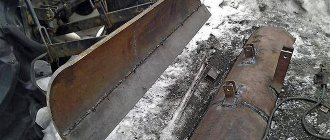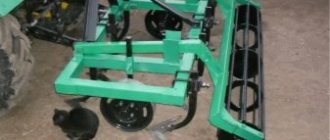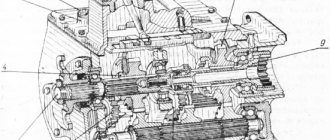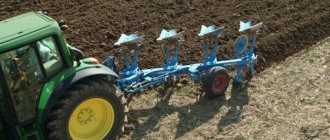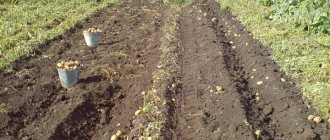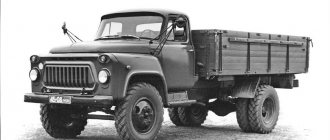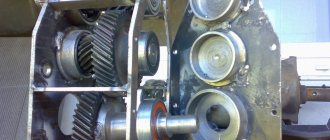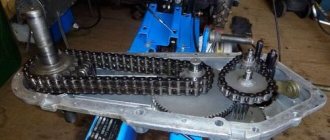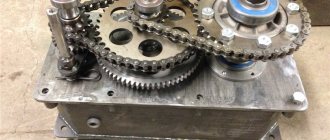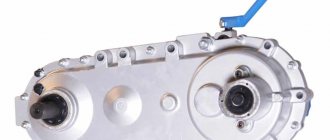What is a reduction gearbox?
It is a special type of mechanism that serves as a transmission link between devices in which the active parts perform rotational motion. It is often used to transmit and convert torque from the unit that produces it to the device that uses the mechanical energy supplied to it. Unlike other types, a reduction gearbox provides a reduction in the number of revolutions and an increase in torque.
A reduction gearbox consists of a housing, gears, transmission chains, a worm mechanism, and shafts, with the help of which torque is transmitted and converted.
Toothed gears are located on the shafts in a rigid coupling, and worm gears are attached. They ensure the transfer of motion to each other, during which its transformation is carried out.
Homemade gearbox for a walk-behind tractor with your own hands: video, drawing, photo
Making a gearbox for a walk-behind tractor with your own hands is a difficult and at the same time interesting task. This is one of the important mechanisms, without which the operation of garden equipment using a walk-behind tractor is unthinkable. Its main task is to reduce the speed of the drive shaft and at the same time increase or decrease the torque to the drive.
You can buy a transmission mechanism for your walk-behind tractor in a specialized store, but it is wiser to assemble the gearbox yourself, taking into account all the technical characteristics of the engine. This will be the best option, since when designing a mechanism for a specific power plant, an individual calculation is made, which will simplify the task of pairing it with the engine.
When starting to manufacture a gearbox, you need to clarify which type of mechanism is preferable for your walk-behind tractor. This depends not only on the power of the engine, but also on its layout, as well as on the level of complexity of the tasks assigned.
Types of gearboxes
The design of any converting device for a walk-behind tractor (gearbox) consists of a set of motion-transmitting shafts or gears of different diameters, enclosed in a durable housing.
Converting devices are divided into several types according to the type of transmission:
- chain;
- belt;
- gear;
- worm (gear-worm);
- combined systems.
For chain-type gearboxes, rotation transmission is provided using a chain and sprockets of different sizes, which are installed on rotary shafts. The operating principle of a belt mechanism is similar to a chain mechanism, but instead of sprockets and a chain, pulleys and a belt are used.
Inside the housing of the gear reducer there are shafts with gears mounted on them, having straight or oblique teeth. Gears transmit rotation from the engine to moving parts. Bevel gears are used in angular mechanisms for heavy walk-behind tractors.
Types of mechanisms
According to the method of operation and action, all transforming mechanisms for walk-behind tractors are divided into several types:
- angular;
- downward;
- reverse with reverse speed (reverse gearbox);
To redirect rotational energy from a vertical drive to a horizontal plane, an angular gearbox using bevel gears (bevel gearbox) is used.
Reducing the number of revolutions and increasing the power of the drive mechanism is provided by reduction gearboxes, or creepers for the walk-behind tractor.
They are considered the most reliable for operating a diesel or gasoline air-cooled walk-behind tractor.
This allows them to be used for particularly difficult work - for example, plowing heavy soil or harvesting potatoes using a potato digger.
In a special article you can find drawings of a potato digger for a walk-behind tractor.
How to make a homemade gearbox for a walk-behind tractor
To independently assemble the converting device on a walk-behind tractor, you need to stock up on the following tools:
- calipers and metal ruler;
- a set of screwdrivers of different sizes, including an oblique one;
- pliers and wire cutters;
- metal saw;
- electric drill with a set of metal drills;
- vice;
- hammers - large and small;
- rubber gaskets.
If you decide to assemble the gearbox for your walk-behind tractor yourself, be sure to make an approximate calculation. This will help determine, at a minimum, the gear ratio and type of converter you need.
Also, using preliminary calculations, you can estimate the dimensions of the future transmission device.
To make the correct calculation, determine the parameters of your engine. For calculations it is necessary to clarify several data:
Let's take a simple example: the engine power at idle, taking into account an increase of 10%, is 600 rpm, and to ensure a speed of 3 km/h, a rotation speed of 200 rpm is required.
Therefore, the design gear ratio is 3:1.
In other words, to reduce the rotation speed of the axle by a factor of three to ensure a travel speed of 3 km per hour, the torque increases three times.
Mechanism elements
Regardless of whether a purchased or homemade reduction gearbox will be used in a walk-behind tractor, you need to understand how the elements of the mechanism are located, how to maintain and repair them. Reduction gearboxes for walk-behind tractors can be of several types, each of which has its own advantages and disadvantages.
Scheme for connecting the speed reducer to the gearbox
Gear reducer
As a rule, it consists of one or two stages; The main elements are gears. This type is one of the most reliable mechanisms used in creepers. Used in the most powerful walk-behind tractors. Its advantages may include:
- durability;
- reliability;
- small dimensions;
- possibility of reverse.
Such creepers are not without their drawbacks, the main ones being maintainability and price. In case of breakdown, as a rule, they are replaced entirely, which requires significant financial costs. In addition, it is necessary to monitor the presence of lubricant, the absence of which can lead to rapid wear.
Worm gear
The main element is the worm gear. Allows you to reduce the dimensions of the walk-behind tractor and improve weight distribution due to the perpendicular arrangement of the drive shafts and wheels. Most often they are installed on light and low-power walk-behind tractors.
Main advantages:
- large gear ratio;
- small dimensions;
- light weight.
The main disadvantage of a worm gearbox is the lack of reverse. In addition, in the event of a breakdown, the stroke reducer is completely replaced.
Chain reducer
One of the most popular types of gearboxes among users. Most often they are made dismountable, which simplifies maintenance and diagnostics. The most common failure is a broken or stretched chain, shearing of sprocket teeth or drive shaft keys. All these breakdowns, as a rule, are quite easy to fix yourself by replacing the failed part.
The advantages of stroke reducers of this type include:
- simplicity;
- reliability;
- possibility of reverse;
- maintainability.
A separate article about a homemade chain gearbox for a walk-behind tractor.
Combined gearbox
Gearboxes of this type are characterized by the presence of different types of gears in one mechanism: gear-chain or worm-chain. The need for such stroke reducers is dictated by the fact that in gear and worm gearboxes the center distance between the drive and driven shafts is regulated by the size of the gear and directly depends on the engagement module and the number of teeth. In a chain drive, the distance between the shafts can be adjusted by removing or adding links.
When assembling the design of a walk-behind tractor, it is not always possible to place all the units in an ideal position, and the need for an intermediate transmission link arises. This function is successfully performed by a chain drive, which compensates for the distance from the gear or worm gear to the wheel or drive shaft.
What does the speed reducer consist of?
Depending on the type of reduction gearbox, a homemade creeper consists of the following main parts: input (high-speed) shaft, output (low-speed) shaft, worm and worm wheel, drive and driven gears or sprockets.
In this case, the driving sprockets and gears always have a larger number of teeth than the driven ones. Auxiliary elements can be various couplings, bearings, and keys. In gear and worm gearboxes there is always a housing, which cannot be said about chain gearboxes. They may either completely lack a case or cover only part of the mechanism.
Maybe you will be interested in making a mower for a walk-behind tractor or an adapter for a walk-behind tractor.
Homemade gearboxes, gearboxes, etc.
I propose to collect homemade gearboxes, gearboxes, drive axles and the like in one place. Discuss methods for manufacturing parts and housings for them. TO THE EDITOR - if there is already a similar topic - please tell me.
here is my bevel gear. gears from the differential from the gear, the axle gear was tucked under the 25 mm shaft and the bushing was welded, the pinion gear was simply welded to the 20 mm shaft, everything else can be seen from the photographs, if you ask for a photo of cutting the splines post-on, I just wanted to show how I cut it with alignment, I didn’t bother
Remember: it’s better to lose a day, then fly to my channel in five minutes https://www.youtube.com/channel/UC1vTkviCAeiA9Z4yTOHM7uQ
Finally the Internet is working. I assembled it 2 years ago to connect the GAZ-51 gearbox and the M-412 bridge. The body is channel 14, gears are from the 51st gearbox (3rd gear, splines are welded into the drive gearbox for the output shaft of the GAZ-51 gearbox), and at the output of the gearbox there is a cut-off secondary shaft of the GAZ-51 gearbox.
Built a boring head.
I'll try to bore it for a homemade transfer case.
Built a boring head.
and what is the cutter itself made of? I thought for a long time about what I could make a reduction gear out of, and today it dawned on me, I found the crown of the launcher and the bendex starter, the gear ratio should be about 7.5 and the chain drive 2.3 in total 17.25, maybe it will be useful for someone, for example, for making a meat grinder.
Preliminary preparation
Before you begin creating this device, you must have general knowledge of mechanics, be able to use repair tools and equipment, and know the operating principle and structure of this unit.
In addition, you need to initially determine:
- the type of future gearbox and its version;
- the gear ratio that will need to be converted and determined at the output;
- indicators of dynamic loads that will affect the working parts of the device;
- weight and dimensions of the future device;
- installation angle;
- temperature limits that will occur in the device during its operation;
- switching cycle – full or variable;
- intensity of operation.
How to make a reverse gearbox with your own hands
The reverse gearbox is included in the main part of the walk-behind tractor - the drive. The durability of the walk-behind tractor depends on its reliability. The task of such a gearbox is to preserve and maintain the performance of the machine in difficult conditions.
Dependence of the mini tractor operation on the gearbox
The walk-behind tractor is designed to facilitate the work of landowners. In order for it to work properly and flawlessly, plowing the ground, removing leaves and dry grass, and planting, it is necessary to have a sufficient supply of power and speed. To find out how to reverse on a walk-behind tractor, you need to familiarize yourself with its structure and the tasks assigned to it.
The lowering reversible unit is called a creeper. They are equipped with all modern installations that run on gasoline or diesel and are air-cooled.
This addition allows the agricultural machine to operate safely under increased load, such as digging up potatoes, cultivating heavy soil, and plowing.
With the help of this reduction unit, it becomes possible to increase power and eliminate wheel pair slipping.
You need to choose power depending on the size of the area:
- 5 hp — from 6 to 10 acres;
- 6 hp - no more than 30 acres;
- 7 hp - up to 50 acres;
For larger plots, a power exceeding 7 hp is selected. The installation diagram includes a gearbox for a mini tractor; it is mounted on the drive shaft, where there is a gearbox on one side and a clutch assembly on the other.
It is represented by gears that mesh using a gear train. The reversible gearbox provides a set of required speeds.
If you decide to make it yourself, then it must be reliable and withstand loads in difficult areas.
You can simply borrow this unit from another device - a motorcycle or mini tractor. It is important to take into account gear ratios. The reverse gearbox on the walk-behind tractor has a ratio of 1:4.62. Compliance with these values guarantees normal operation of the unit: improved running and traction performance and unloading of the drive gearbox.
Manufacturing of a reversible gearbox
If you want to build a unit at your own discretion, then you cannot do without a borrowed housing. It is impossible to do it yourself outside of factory conditions. The material used is cast iron or aluminum alloy. The body is produced using special equipment. To make a reversible gearbox at home, you need to start with the housing.
If it was not possible to select from other mechanisms, then it can be built from a gas pipe with thick walls with an outer diameter of 2.73 cm. Internal components: axles, gears. They must withstand the loads to which the homemade reverse gearbox will be subjected.
Regarding seals, bearings, fuses, it is recommended to select them based on the design.
A homemade reverse unit can actually be assembled from the elements that make up the main gear on a used GAZ-69 car. Hubs, bushings for reverse, sprockets, rod, fork are machined from metal. 45 steel is suitable for this. Finished parts must be hardened. You should be very careful in the manufacture of cams on the hubs, as well as reversible bushings, since they will be subject to increased dynamic loads. The drive and driven gears must be isolated from each other by a gasket, the thickness of which can be adjusted to the degree of their pressing.
How to assemble a gearbox with high quality
Schemes for switching the direction of movement of an agricultural machine are as follows:
- The drive sprocket, located on the main shaft, transmits the torque to the bevel gear, which is the drive gear.
- 2 bevel driven gears are mounted on a splined shank. One of them, which is engaged by a reversible bushing with a spline on the main shaft, begins to rotate. In this way, transmission occurs either to the differential or to the wheels of the car.
- The rod of the reversing device is equipped with a fork. It flips the direction-changing sleeve to the right in one direction, or to the left in the other direction, or to neutral. This is how commands are implemented that change the direction of movement.
- A homemade reversible gearbox is controlled using a rod lever.
A do-it-yourself reduction unit will be considered high quality if the following factors were taken into account during its manufacture:
- rated power;
- permissible limit temperature under extreme conditions;
- rotational speed;
- permissible loads on axles and parts;
- the size of the gearbox angle;
- torque value;
- type of lubricant for rubbing parts;
- frequency of work.
If the gearbox for a mini tractor is used incorrectly, it may fail. The following reasons may lead to this:
- excessive load causes a large release of heat, this leads to overheating of the shaft and transmission parts, teeth may break, shocks will be heard in the chassis, and uncontrollability will appear when the speed decreases;
- incorrect choice of gear ratio;
- neglect of routine repairs, which includes a preliminary inspection of the engine and main components.
Thus, since the walk-behind tractor has a certain speed range, it is therefore important that when switching them, the functionality of all components is maintained.
A self-made gearbox ensures an increase in power with a sharp drop in speed to a minimum value.
The lowering unit must necessarily complement the design of the machine, since it is used to cultivate the ground, remove snow, leaves, grass, and various materials.
Source: https://1sadteh.ru/komplekt/revers-reduktor.html
Definition of a gearbox and its purpose
The most important part of the walk-behind tractor is the gearbox. This is the main drive of the entire mechanism with which the agricultural unit operates. It is important for the owner to know that the life of the walk-behind tractor depends on the gearbox, so you need to choose a high-quality, reliable mechanism.
The purpose of the gearbox is to convert and transmit torque, which is generated from a mechanical transmission and thereby makes the machine mechanism work.
Types of gearboxes
There are several types of gearboxes:
- angular;
- gear;
- downward;
- and reverse gearbox.
Angular reverse gear unit
This is one of the effective gearboxes. Its task is to ensure that the transmission is connected to the engine. The owner can improve the angular gearbox himself, which will help increase the power of the gearbox. The mechanism consists of:
- generator housing;
- flange;
- flange mounting;
- keys and steel washer;
- pulley fastening;
- a pulley that has a V-belt drive;
- rotor shaft;
- flange bearing.
To design a bevel gearbox, you don’t need a lot of knowledge. Even minimal skills in its manufacture are acceptable here.
Description of reduction and gear drive
The reduction gearbox serves to reduce the number of revolutions and maximize power.
This type of gearbox is the most reliable and powerful because it has a special cooling system that is used to cool the air, so walk-behind tractors can withstand heavy loads and can perform a variety of functions. When plowing, even large blocks are not an obstacle for them.
The gear reducer has the simplest device. The transmission of this mechanism is the transmitter between the engine and the wheels. The advantage of the gear reducer is its simple and reliable operation.
Reverse mechanism
In a reverse drive, the clutch is located between bevel gears, which are located on the main shaft. This device has a name: a reversing circuit, which is not at all complicated.
The advantage of this equipment is to reverse, which is often very necessary for the car in various situations. Of course, this system does not provide the possibility of obtaining high speeds, but this is not a big drawback.
So, having examined the types, structure and operating principle of various gearboxes, we come to the conclusion that it is possible to make them yourself at home.
Making a reverse gear manually
Now the main task: how to make your own gearbox for a walk-behind tractor so that the engine is powerful and reliable? To simplify the work in the manufacture of the mechanism, you can take a ready-made sample, for example, from Dnepr or Ural motorcycles. The following details must be present:
- ruler and calipers;
- straight and oblique screwdriver;
- metal file;
- pliers, wire cutters;
- hammers and vices of different sizes;
- rubber gaskets, preferably several different ones.
First you need to prepare the housing for the reverse gearbox. A two-inch fitting elbow works well for this. You can make it yourself; to do this you need to weld a body of metal plates.
They also use a generator shaft from a Ural motorcycle. It is simply masterfully refined. Gears for the gearbox can be used from the Druzhba chainsaw. Remove the end stop in one of the shafts, then drill a hole of the required diameter. It is important to remember that to perform this work you must have all the necessary tools, since the quality of the drive depends on this.
Mount the other gear shaft, along with bearings and its cage, into the gearbox housing on the opposite side. And already on the output shaft the owner must install a pulley that ensures rotation using a V-belt drive. Finally, bearings - fans - are attached to the hood frame using welding.
This is how you can design a small tractor for your household yourself with minimal investment.
Diagram of a gearbox assembled from parts of a decommissioned car
This gearbox is assembled from parts of the main drive of the GAZ-69 vehicle. The bevel gears rotate from the drive sprocket, which is mounted on the shank.
The torque is then redirected to one of the two driven gears, which rotate in bearings numbered 206 on the spline shaft. At the right time, the gear that engages with the reverse sleeve on the central spline of the shaft works.
Then the cardan transmits the movement to the differential or the drive wheel of a mechanical vehicle.
And the final important point for owners of walk-behind tractors or mini tractors. When purchasing a mechanism, price also plays an important role, because cheap units are mostly equipped with non-separable gearboxes.
Such mechanisms are unreliable for long-term operation. If necessary, this gearbox cannot be repaired, disassembled or reassembled, or parts replaced.
It is made of low quality metal, its parts are not gelled.
Expensive units are equipped with gearboxes that can be disassembled, which allows for gearbox maintenance and repairs.
Like any other mechanical vehicle, it needs constant rechecking, repair, and updating, and the gearbox must be constantly inspected and monitored.
From time to time it is necessary to carry out diagnostics of the mechanism to prevent breakdowns in the future.
When purchasing, it is more profitable to buy a more expensive gearbox, because it will serve you longer.
If you have any questions, leave them in the comments below the article. We or our visitors will be happy to answer them
Reviews of one-stage modifications
Most experts speak positively about single-stage gearboxes. However, it is important to understand that high-quality models are assembled with adapter pushers. They use sharpened heads and do not rub against the discs. It is more expedient to install the gearbox shaft behind the partition. The gear is most often fixed in front of the rack.
It should also be noted that there are compact modifications with a small shaft. They have small pressure disks; the device is not able to maintain high engine speeds. The holders are installed in a cylindrical shape. Pressure plates are used with and without adapters. Rollers are used to reduce friction, and bearings are installed at the base of the shaft. It is important to pay special attention to the block during assembly. In order for the case to withstand heavy loads, it must be carefully soldered. At the end of the work, all that remains is to weld the lid.
Important elements: engine and intermediate gearbox of a mini tractor
The owner of such a vehicle has no problem finding a gearbox or engine for a mini tractor in our product catalog. Thanks to the constant replenishment of the assortment, we will always help you purchase:
• engine (assembled, with radiator, fuel tank, generator and repair kit); • intermediate gearbox for attachments; • hood with headlights assembly; • rear and front wheels; • front axle and other parts.
The MotoImport online store has spare parts for mini tractors!
More details about the components
The assembly process is not as complicated as the selection or production of spare parts necessary for such a gearbox.
- Device body. In industry it is produced by casting. The necessary holes are made using high-precision equipment, since it is necessary to achieve the mutually correct arrangement of the shafts and the alignment of the stars. When producing it, it is necessary to make the top cover removable. This will facilitate and simplify the process of servicing it during operation;
- Shafts and axles of the gearbox. They support gears and are used if they need to be equipped with this device. Installation is carried out by pressing onto splines or keys. For their manufacture, it is better to use durable steel measuring from 10 to 45 mm, which is easy to machine;
- Bearings. They are used as supports for shafts and resist loads and provide the possibility of rotational movement. Its reliability, durability and performance depend on the correct selection of these gearbox elements. If you are installing spur gears, then it will be sufficient to install conventional single or double row ball bearings. If a helical bearing or worm gear will be installed, then a roller or angular thrust ball bearing will be the best option. It is better to buy new ones than to use them from disassembly;
- Gears. They provide a change in the rotation speed of the shafts and, naturally, a reduction in the gear ratio. For their production, special metal-cutting equipment is used, which home workshops are not equipped with. The dimensions and characteristics of other parts included in this unit, as well as the distance between the axles and shafts, depend on the size of the gears. When installing, it is important to correctly set the gap between them. I-20 oil is perfect for lubricating gears. It is filled to the level of the bottom of the gears. Other parts of the device are lubricated by spraying lubricant onto them. You can take it from disassembly or buy new ones;
- Oil seals. They prevent oil from leaking out of the device body. They are installed at the exit points of the shafts on bearings under the covers. Are bought;
- Safety coupling. It is designed to prevent destruction of the device when excessive loads occur. Buyable;
- Bearing caps. They can be different - deaf and through. Designed to facilitate maintenance and installation of bearings. You can grind them yourself or find them at a disassembly site.
How to make a homemade walk-behind tractor with an ant gearbox
A two-stage chain gearbox is designed to reduce the rotation speed and increase the torque transmitted from the output shaft of the power unit of the walk-behind tractor to the wheels or cutters.
Chain gear drawing
1 - body made of channel No. 20); 2 - cover made of Art. sheet s5); 3 — gasket made of oil and petrol resistant technical plate) 4 — second stage drive sprocket (z = 11, t = 19.05); 5—key; 6 — bearing 206 (2 pcs.); 7— compensation sleeve; 8 - shaft; 9 — nut M22x1.5 with a spring washer; 10 - oil seal; 11 — spacer bushing with keyway; 12—eccentric bearing housing (StZ, 2 pcs.); 13 — M8 screw with spring washer (30 pcs.);
14 — driven sprocket of the second stage (z = 25, t = 19.05); 15— bearing 3008 (2 pcs.); 16 — bearing housing; 17 — sealing sleeve; 18 — left axle shaft; 19—oil drain plug (M10 screw); 20 - bottom of the body from Art. sheet s4); 21 — oil filler plug (screw Ml0); 22,23 — oil seals (2 pieces each); 24 — right axle shaft; 25 — M6 fixing screws (8 pcs.); 26 — M8 bolt; 27 - chain t = 19.05; 28 — driven sprocket of the first stage (z = 57, t = 12.7); 29 — spacer sleeve
The first stage of the gearbox includes two sprockets with 17 and 57 teeth, respectively, with a pitch of 12.75 mm. The drive sprocket with 17 teeth sits on the output shaft of the power unit, the driven sprocket sits on the outer flange of the second stage input shaft.
The second stage of the gearbox is reinforced and has a drive sprocket of 11 teeth and a driven sprocket of 25 teeth, a tooth pitch of 19.05 mm. Since during the operation of the walk-behind tractor, the second stage is located close to the cultivated soil, it is protected from dust by a closed crankcase, which is directly connected by welding to the cross members, and the crankcase side members are connected by welding through steel spacers.
A strut is welded between the crankcase and the cross member for reliability. The crankcase is welded from two channels No. 2 with shelves that are reduced in length to 35 mm. In the lower parts, the walls of the channels have the shape of a semicircle; instead of cut shelves, a bottom is welded from a 4 mm steel sheet, which is curved along the walls of the channels in the shape of a semi-cylinder. The top of the crankcase is closed with a cover with a gasket made of oil- and petrol-resistant technical plate.
Two coaxial holes d = 100 mm are made in both walls for bearing housings. Around each of them there are six other threaded holes with M8 threads, the purpose of which is to fasten the housings to the crankcase. The lower axle shaft bearings have normal housings, while the upper shaft bearings have eccentric housings. By rotating them around their axis by at least 15°, the tension of the chain of the second stage of the gearbox is adjusted in steps.
The shaft of the second stage of the gearbox is mounted in two ball bearings 206. By means of two spacers, the drive sprocket is fixed exactly in the middle between the inner walls of the crankcase and connected to the shaft by means of a feather key. On the centering boss of the right axle shaft sits a large driven sprocket, secured with six M8 bolts between the opposing flanges of the axle shafts. The lower part of the large driven sprocket and part of the chain are constantly immersed in oil.
When the walk-behind tractor engine is running, the moving chain transfers oil to the upper part of the crankcase - thus lubrication of the rubbing parts of the second stage is organized. To prevent oil leakage, oil seals are provided in the bearing housings. A rigid flange connection of the axle shafts forms a single shaft mounted in two 308 ball bearings.
Source: motoblok-kultivator.com
Transmission
The task of a homemade mini tractor transmission is to transmit torque from the engine to the drive wheels, change the speed of movement and provide reverse.
When driving in a lower gear, the engine is protected from overheating by an additional cooling system. Depending on the engine used and the wheel arrangement, the transmission layout may be different:
- Simple. Torque is transmitted through a belt clutch, which is installed on the gearbox.
- Complex. To transmit torque, you need to use cardan shafts.
A complex scheme is often used on homemade products with a breaking frame. This is a labor-intensive option for self-production. For this purpose, a 4x4 wheel arrangement is made with a Niva transfer case.
Purpose and types of gearboxes
Diagram of the angular gearbox of the walk-behind tractor: 1 - retaining ring, 2 - adjusting ring, 3 - bevel gear, 4 - adjusting rings, 5 - bearing, 6 - intermediate gear shaft, 7 - upper housing, 8 - output shaft, 9 - adjusting rings , 10 — bearing, 11 — bevel gear, 12 — retaining ring, 13 — boot cup, 14 — boot, 15 — cuff, 16 — adjusting rings, 17 — lower housing, 18 — adjusting shim, 19 — bearing, 21 — cover , 22 - gear, 23 - gear, 24 - shaft.
An important element of the walk-behind tractor design is the gearbox. It transmits torque from the engine shaft to the working tool or wheels of the unit, depending on the design. Thanks to the features of the device, torque is not simply transmitted, but is amplified with a simultaneous reduction in the number of revolutions of the driven shaft.
According to their design, gearboxes can be of several types:
- Geared. The gearbox consists of shafts with cylindrical and bevel gears mounted on them. By design, gear reducers can be implemented in a straight pattern (torque is transmitted through a spur gear) or angular (a bevel gear is used to transmit torque from the driven shaft directly to the gearbox).
- Gear-worm. Used with a vertical engine crankshaft. The gearbox consists of a worm gear and a worm (a metal screw with a large-pitch rectangular thread). A special feature of this gearbox is the transmission of rotation at an angle of 90°.
- Chain. Torque from the engine to the gearbox shafts is transmitted by a metal chain that rotates the sprockets.
- Belt. It is analogous to the chain method with the only difference that instead of a chain, a V-belt or rectangular belt is used, and instead of sprockets, pulleys with profile grooves are used to hold the belt.
The design of a motor cultivator often uses angular gear-worm or chain gearboxes. Gear reducers are used in the designs of powerful units. The belt transmission method is quite rare, because It is believed that the belts are prone to breaking and slipping from their seats.
Classification
In the direction of the turn, transmissions are mostly right-handed. Sometimes the left direction of the thread is found.
Worm gears are classified according to the shape of the outer surface of the worm:
- cylindrical;
- Globoid.
The concave surface of the drive part increases the number of teeth that are in mesh at the same time. As a result, efficiency and transmission power increase. The disadvantage of globoid worms is that they are difficult to manufacture. The coils must be of the same height with a concave outer surface.
Worms are distinguished by the shape of the thread:
- Archimedean;
- convolute;
- nonlinear.
The Archimedes worm is distinguished by a straight involute in cross-section. The convolute has a convex configuration, close to the shape of a regular gear. Nonlinear profiles have a convex and concave surface.
The gear wheel has an inclined tooth of a reverse configuration, the shape of which coincides with the cavity between the threads.
The location of the worm relative to the wheel can be:
- top;
- lateral;
- lower.
The upper one is optimal for high-speed gears. The side one is the most compact. With the crankcase lubrication method, the oil is in the sump and the lower part, rotating, lubricates the rest; the lower location of the worm is more convenient.
Worm wheels are helical gears. The axes of the parts are usually located at an angle of 90°. In heavily loaded mechanisms, the angle can be 45°.
Gear wheels are divided according to the tooth profile:
- roller;
- concave;
- straight.
By type they can be:
- with continuous rotation – full;
- gear sector.
The sector can be of different sizes, from half a circle to a working length shorter than a worm.
Selecting parameters
The type of activity for which the equipment is intended determines the parameters of the future machine.
The dimensions of a homemade mini tractor will depend on the track width, the size of the units and transmission elements, and the engine power is related to such characteristics as the severity of the cargo being transported, the type of soil, and the number of plows used. Therefore, before starting to build a tractor for the household with your own hands, you need to decide on the following:
- Dimensions. Maneuverability and the ability to work in small areas depend on them.
- Engine power and type. Diesel engines are more suitable for this type of technology due to their good traction at low speeds. Diesel is 25% more economical than a gasoline engine with the same power. It is more unpretentious and durable.
- The equipment used will depend on engine power, torque at the drive wheels, and ride height. If the equipment will be used in winter, then it is necessary to provide for mounting a blade for clearing snow.
- Availability of PTO. It is needed to connect a potato digger, hay mower, and irrigation system pump.
Devices with two clamps
Modifications to two clamps fold with a dual camera. A total of two disks are required for assembly. The coupling itself is matched with a support spring. Many experts say that it is more advisable to use U-shaped pushers. A lever is used to change gears. If you believe the reviews of experts, then the gears take a very long time to fill. In this case, it is important to fix the shaft at the base of the chamber. At the end of the work, all that remains is to make a holder for the rollers.
Motoblock gearbox design
Like any other mechanism of a walk-behind tractor, the gearbox of an agricultural implement consists of certain elements. Taking into account the type of gearbox, its design can be equipped with certain parts. Basically, the gearbox design in detail looks like this:
- Cover and pulley;
- Bearings;
- Bushings on the input shaft;
- Adjustment and shift lever;
- Shift fork and shaft;
- Gear in the intermediate shaft;
- Shaft block;
- Double-row chain;
- Sprocket block;
- Washers and seals;
- Input shaft;
- Right and left axle shafts;
- Double star;
- Clutch;
- Bracket and spring;
- Clutch fork.
The mechanism diagram below will tell you in more detail how the walk-behind tractor gearbox works.
Despite the rather complex design of the mechanism, its dismantling and reassembly will not raise any questions even for a beginner. To do this you need:
- Completely remove the gearbox from the walk-behind tractor;
- Unscrew the screws and remove the protective covers;
- Carefully remove the bushing on the input shaft, dismantle the lever and fork that switches the mechanism;
- Remove the input shaft and gear from it;
- Remove the shaft bushings and chain;
- Dismantle the shaft block and remove the sprockets from it;
- Remove the intermediate shaft along with the gears;
- Remove the clutch, left and right axle shafts.
After completing all of the above steps, you will receive a disassembled walk-behind tractor gearbox. After repair, the mechanism must be reassembled in reverse order.
What drawings will be needed
In order to have a clear plan for working on a project to build a mini tractor, you will need a drawing or sketch of it. They are compiled based on the required parameters and those assembly units that need to be installed.
The tractor is assembled at home from components of motorcycles, walk-behind tractors and used cars. Therefore, the drawings are drawn up based on the units that are available.
First, a diagram is drawn on which the engine, gearbox, transfer case, and chassis are located. These assembly units are arranged according to their design features and dimensions. A kinematic diagram of torque transmission from the engine to the drive wheels is drawn up. The drawing then displays the design features:
- frame dimensions;
- material;
- attachment points for units, suspensions;
- elements reinforcing the structure.
The remaining drawings are not as important as the frame drawing because they are constantly being adjusted during production.
Making a reverse gearbox with your own hands
If you want to independently manufacture a gearbox of type RRP 15, you need to find all the necessary structural elements in advance, as well as prepare the tools. To assemble the device, a standard set of tools is sufficient - a screwdriver, a hacksaw, pliers, a vice, and some other tools. In addition, the master will definitely need a welding machine.
For successful assembly, it is advisable to adhere to the following algorithm of actions:
- Assemble the body, preferably from metal plates. If desired, you can use the shaft housing from the Urals, but further modification will be required.
- The gears for the mechanism are easiest to take from the popular Druzhba chainsaw, which is widely found among domestic consumers.
- Connect all the necessary elements in accordance with the diagram.
Since the service life of the gearbox directly depends on the quality of the original components, it is strongly recommended to use parts with a minimum degree of wear.
Homemade gearbox diagram
Since this type of device has a complex design, there is a high probability of making mistakes when assembling it yourself. A detailed diagram will help you avoid them, with the help of which you can easily determine the position of each element, as well as the method of connecting them.
Walk-behind tractor design
Schemes for assembling homemade walk-behind tractors are as varied as the spare parts in each owner’s garage. Dimensions are also chosen for practical reasons.
With different compositions and dimensions, there are required elements:
- The frame is a durable structure for attaching other parts.
- Wheels - from homemade metal to factory-made rubber. The position of the wheel or wheelset axle is fixed relative to the frame by iron struts with pressed-in bearings.
- Engine - power from 5 to 10 horsepower. You can even use an electric motor with a battery, but the most popular are engines from a scooter or motorcycle. This choice is good because it has a ready-made speed control and even a transmission device.
- Gearbox is a unit for transmitting rotation from the engine to the actuator, converting speed and direction.
But the first gearbox you come across may not be suitable. You need to choose the type of structure, calculate the size of each part, so that the speed and power of movement of the mounted cultivator allows you to cultivate the land in a convenient mode - neither quickly nor slowly.
Do-it-yourself winch - price
If you have your own garage or shed with rubbish accumulated over several years of home plumbing, the cost of the product is determined by the price of a can of spray paint for final finishing.
Basically, the components are as follows:
- Starter from a VAZ 2101 car without a planetary gearbox (working, lying in the garage);
- A gearbox in a housing from a domestically produced electric drill (purchased at a flea market for the equivalent of 0.5 vodka);
- A piece of water pipe found in a barn;
- Metal for the frame, body walls, drum. Also found in a barn;
- Drum axle - purchased at a scrap metal collection point for pennies;
- The rope and hook were purchased at a tourism supply store.
Taking into account the cost of a new winch, the cost of the issue can be considered zero. At the same time, the owner can vouch for the safety of the device. Every detail and weld is personally checked by the manufacturer.
Source: obinstrumente.ru
Attachments
The hitch on the mini tractor allows you to carry out any agricultural work:
- plowing;
- planting potatoes;
- hilling;
- cultivation;
- hay making;
- transportation of goods.
Equipment such as a plow, hiller, and cart are easy to manufacture. They can be made from scrap materials. However, their price in stores is also low.
Video
The operation of a homemade reverse gearbox is shown in the video.
Owners of home workshops have many devices and devices that greatly facilitate manual labor and increase work efficiency. One such mechanism is a reduction gearbox. It is mainly used to change the rotation speed of the output shaft downward or increase the torque on it. By its design, this device can be combined, worm or gear, as well as single- and multi-stage. Many people make a reduction gearbox with their own hands.
Angular gearbox made of satellites
Moderator: User buggy
Angular gearbox made of satellites
Weather report » Sat Mar 28, 2015 6:19 am
Re: Angle gear made from satellites
Post by ed24ru » Sat Mar 28, 2015 7:01 am
Re: Angle gear made from satellites
Weather report » Sat Mar 28, 2015 7:29 am
Re: Angle gear made from satellites
Weather report » Sat Mar 28, 2015 7:31 am
Re: Angle gear made from satellites
Post by RusWin » Sat Mar 28, 2015 9:53 am
Re: Angle gear made from satellites
Weather report » Sat Mar 28, 2015 7:04 pm
Re: Angle gear made from satellites
Post by mmcl200 » Mon Mar 30, 2015 3:30 pm
Re: Angle gear made from satellites
Post by Ivan66 » Mon Mar 30, 2015 8:38 pm
Re: Angle gear made from satellites
Post by Black_Arrow » Fri Apr 03, 2015 11:13 am
